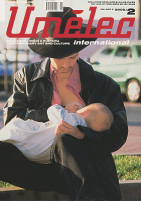| Revista Umělec 2002/2 >> Enwezor Puts On Sober Megashow | Lista de todas las ediciones | ||||||||||||
|
|||||||||||||
Enwezor Puts On Sober MegashowRevista Umělec 2002/201.02.2002 Vladan Šír | exhibition | en cs |
|||||||||||||
|
This year’s Documenta (Kassel, Germany, 8 June–15 September) clearly proved the increasing tendency of art as activism — be it political, ecological, or social.
Artistic director Okwui Enwezor and his team of curators gathered 116 artists from 45 countries to participate at this megashow, which takes place only once every five years. Artists from African nations and a number of Asian states had a strong representation, but Central and Eastern European artists were scarce, at least as compared to Western European artists. This situation created a bit of a paradox, in that most of the artists presented as coming from “developing countries” actually live in the centers of western contemporary art. Kassel is the ultimate platform of Documenta 11. The one-year project began in New Delhi, where philosophers, writers, artists, architects, political activists, lawyers, academics, and others met at a platform called Experiments with Truth: Transitional Justice and the Process of Truth and Reconciliation. Three other meetings followed: Democracy Unrealized in Berlin and Vienna, Creolite and Creolization in St. Lucia, West Indies, and Under Siege: Four African Cities, Freetown, Johannesburg, Kinshasa, Lagos in Lagos. (More information can be found at www.documenta.de.) Documenta 11’s four exhibition halls and exterior pieces presented a number of socially tempered projects emphasizing activism and engagement: architectural designs, documentary photography and almost museological installations. Some of the works all but took up their entire pavilion. New Yorker critic Peter Schjeldahl hit the nail on the head when he wrote in July: “Documenta 11 declares, in effect, that art is too powerful a force in the world to abide the hedonism of aesthetes and the punctiliousness of art scholars.” In fact, several Documenta participants, including Gaston A. Ancelovici, Le Groupe Amos and the Raqs Media Collective seldom engage in artistic production at all. But it’s not all that bad with hedonism at Documenta 11. Take the huge Binding-Brauerei, evocative of a multiplex movie theater filled with projection halls, wall-to-wall screens and auditoriums. Films that didn’t make it to the big screens, such as James Coleman’s, appeared on flat, wall-mounted monitors. Projects made for computers were presented on liquid crystal displays. Despite the works’ political quality and technological flamboyance, Enwezor et al. managed to put together a sober and compelling exhibition. There was no dry agitprop, and technology didn’t kill the experience. Some works were rather snappy and witty, such as Anette Messager’s plush animals and objects scattered on the floor and swinging from the ceiling on elastic ropes, while a dead plush cow was dragged around in circles by rope around its neck. Isaac Julien’s film Paradise/Omeros was a visual feast, in which paradise is an allegory for life in the wealthy West. Drawings by Raymond Pettibon were quite provocative. All in all, Documenta 11 made a trip to Kassel worthwhile. Although the exhibition as a whole wasn’t exactly esthetically fly, one was leaving the German town with satisfied.
01.02.2002
Artículos recomendados
|
|||||||||||||













Comentarios
Actualmente no hay comentariosAgregar nuevo comentario